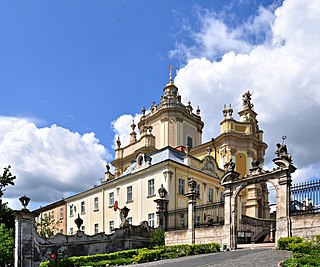
The Ukrainian Greek Catholic Church (UGCC) is a major archiepiscopal sui iuris ("autonomous") Eastern Catholic church that is based in Ukraine. As a particular church of the Catholic Church, it is in full communion with the Holy See. It is the third-largest particular church in the Catholic Church after the Latin Church and the Syro-Malabar Church. The major archbishop presides over the entire Church but is not distinguished with the patriarchal title. The incumbent Major Archbishop is Sviatoslav Shevchuk.

Bila Tserkva is a city in central Ukraine. It is situated on the Ros River in the historical region of right-bank Ukraine. It is the largest city in Kyiv Oblast and serves as the administrative centre of Bila Tserkva Raion and Bila Tserkva urban hromada, and has a population of 207,273.
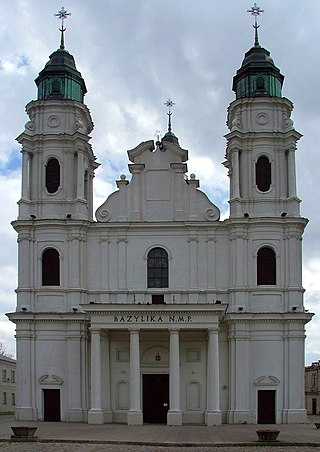
The Basilica of the Birth of the Virgin Mary is a church and monastery complex of the Roman Catholic Church located in the Polish city of Chełm. The church and the courtyard of the basilica stand in the centre of Chełm on Chełm Hill. Over its history, the church has been Orthodox, Uniate and Roman Catholic. Surrounding the basilica's grounds is a city park and a cemetery.

Łukawiec is a village in the administrative district of Gmina Wielkie Oczy, within Lubaczów County, Subcarpathian Voivodeship, in south-eastern Poland, close to the border with Ukraine. It lies approximately 6 kilometres (4 mi) north-west of Wielkie Oczy, 12 km (7 mi) south of Lubaczów, and 80 km (50 mi) east of the regional capital Rzeszów. Łukawiec has existed since the XVIth Century.

The Wooden Tserkvas of the Carpathian Region in Poland and Ukraine are a group of wooden Orthodox churches located in Poland and Ukraine which were inscribed in 2013 on the UNESCO World Heritage List which explains:
built of horizontal wooden logs between the 16th and 19th centuries by communities of Orthodox and Greek Catholic faiths. The tserkvas bear testimony to a distinct building tradition rooted in Orthodox ecclesiastic design interwoven with elements of local tradition, and symbolic references to their communities’ cosmogony. — World Heritage Centre

Saints Peter and Paul Garrison Church, known as the Jesuit Church, is an historic church in Lviv, Ukraine, built in years 1610-1630.

The Church of the Birth of the Blessed Virgin Mary is a modernistic church of the Ukrainian Greek Catholic Church in the city Biały Bór, Bazylego Hrynyka Street, in the West Pomeranian Voivodeship of Poland.
Zarvanytsia is a small village in the Eparchy of Ternopil-Zboriv. It has just over 300 citizens and is located in Ternopil Raion of Ternopil Oblast in western Ukraine, about 20 km (12 mi) SW from Terebovlia, 22 km (14 mi) N of Buchach and 18 km (11 mi) SE of Pidhaitsi, within an oxbow loop of the Strypa River. Zarvanytsia belongs to Zolotnyky rural hromada, one of the hromadas of Ukraine. The village is known for its icon of the Mother of God, reputed to work miracles, and is a popular site of pilgrimage, attracting Ukrainians both from the country as well as the diaspora scattered around the world.
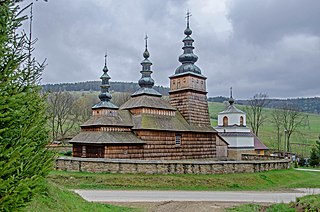
Protection of Our Most Holy Lady Church in Owczary is a Gothic, wooden church located in the village of Owczary from the seventeenth century, which together with different tserkvas is designated as part of the UNESCO Wooden tserkvas of the Carpathian region in Poland and Ukraine.
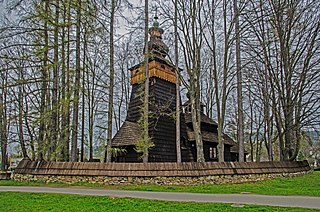
St. James Church is a Gothic, wooden church located in the village of Powroźnik, southern Poland. It dates from the seventeenth or eighteenth-century. Together with different tserkvas it is designated as part of the UNESCO World Heritage Site "Wooden tserkvas of the Carpathian region in Poland and Ukraine".
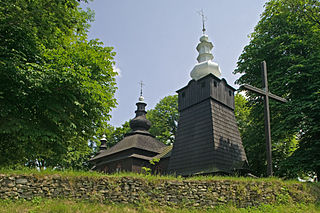
St. Michael Archangel's Church in Brunary is a Gothic, wooden church located in the village of Brunary from the eighteenth-century, which together with different tserkvas is designated as part of the UNESCO Wooden tserkvas of the Carpathian region in Poland and Ukraine.

St. Michael Archangel's Church in Smolnik - a Gothic, wooden church located in the village of Smolnik from the eighteenth-century, which together with different tserkvas is designated as part of the UNESCO Wooden tserkvas of the Carpathian region in Poland and Ukraine.

St. Michael Archangel's Church in Turzańsk is a nineteenth-century wooden church located in the village of Turzańsk, which together with different tserkvas is designated as part of the UNESCO Wooden tserkvas of the Carpathian region in Poland and Ukraine.

St. Paraskevi Church in Kwiatoń - a Gothic, wooden church located in the village of Kwiatoń from the nineteenth-century, which together with different tserkvas is designated as part of the UNESCO Wooden tserkvas of the Carpathian region in Poland and Ukraine.

St. Paraskevi Church in Radruż is a Gothic, wooden church from the sixteenth-century located in the village of Radruż, Poland, which together with different tserkvas is designated as part of the UNESCO Wooden tserkvas of the Carpathian region in Poland and Ukraine.
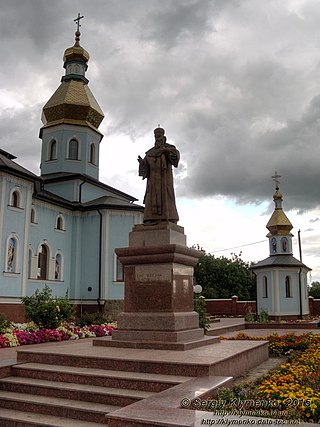
Kovalivka is a village of Bila Tserkva Raion, Kyiv Oblast, Ukraine. It hosts the administration of Kovalivka rural hromada, one of the hromadas of Ukraine. The village is administered by its own rural council. The population is approximately 1,500.

The Co-Cathedral of the Nativity of the Blessed Virgin Mary,, also called Żywiec Cathedral, is the main Catholic religious building in the city of Żywiec, Poland, and the co-cathedral of the Diocese of Bielsko–Żywiec.

The Monastery of Holy Mother of God is a female Orthodox monastery in Turkowice, part of the Diocese of Lublin and Chełm of the Polish Orthodox Church.
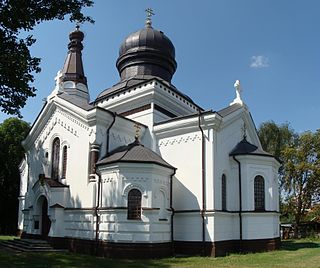
The Church of the Nativity of the Blessed Virgin Mary is an Orthodox parish church located in Włodawa. It belongs to the parish of the same dedication, which is part of the Chełm Deanery of the Diocese of Lublin and Chełm of the Polish Orthodox Church.

The Church of Saints Anthony of Kiev and Martyr Paraskeva is an Orthodox filial church in Hola. It belongs to the Parish of the Exaltation of the Holy Cross in Horostyta, in the Chełm Eparchy of the Diocese of Lublin and Chełm of the Polish Orthodox Church. It is located near the Museum of Material Culture of the Chełm and Podlachia in Hola. Near the church, there is an Orthodox cemetery with the Chapel of the Protection of the Mother of God.



















